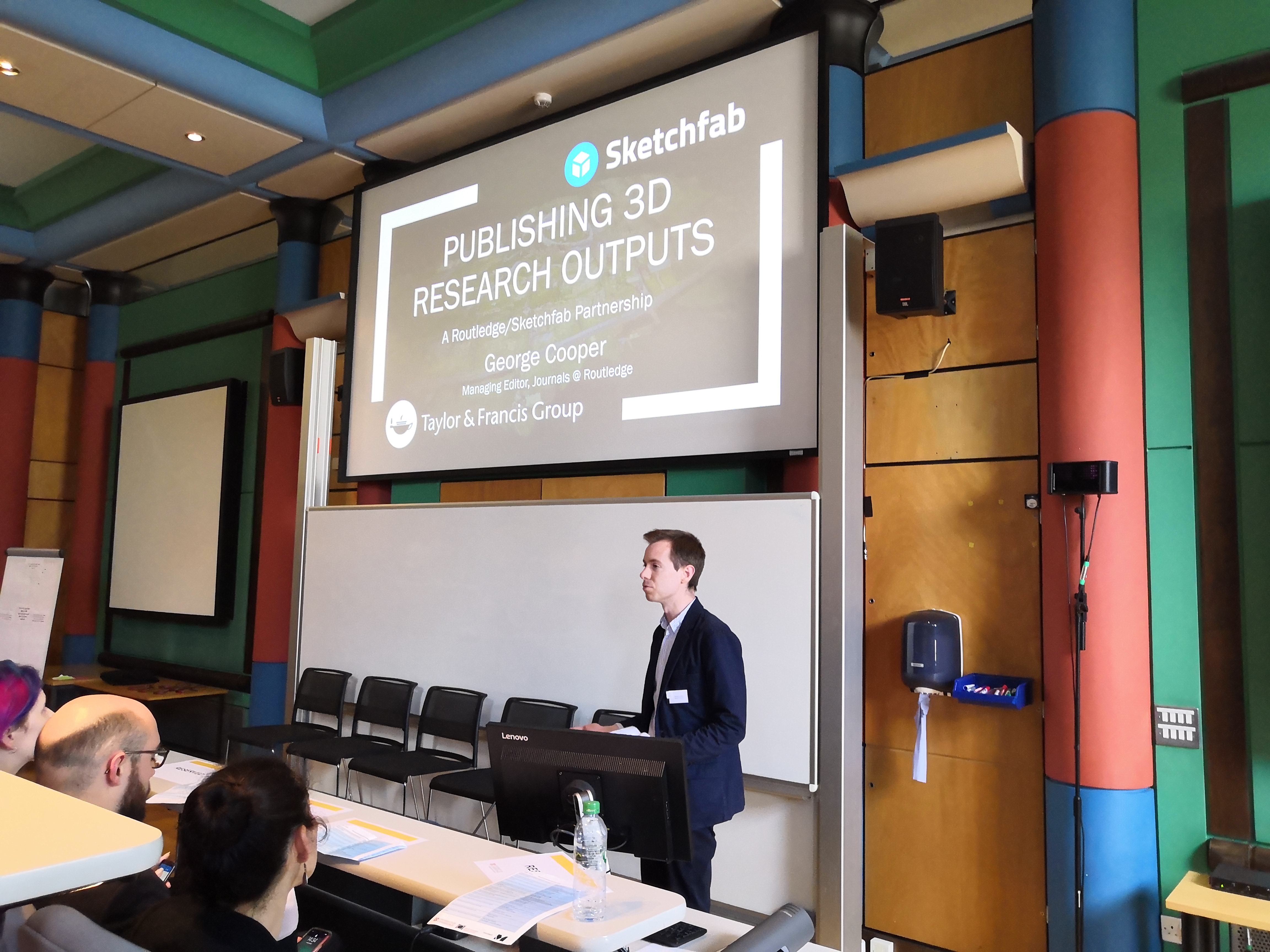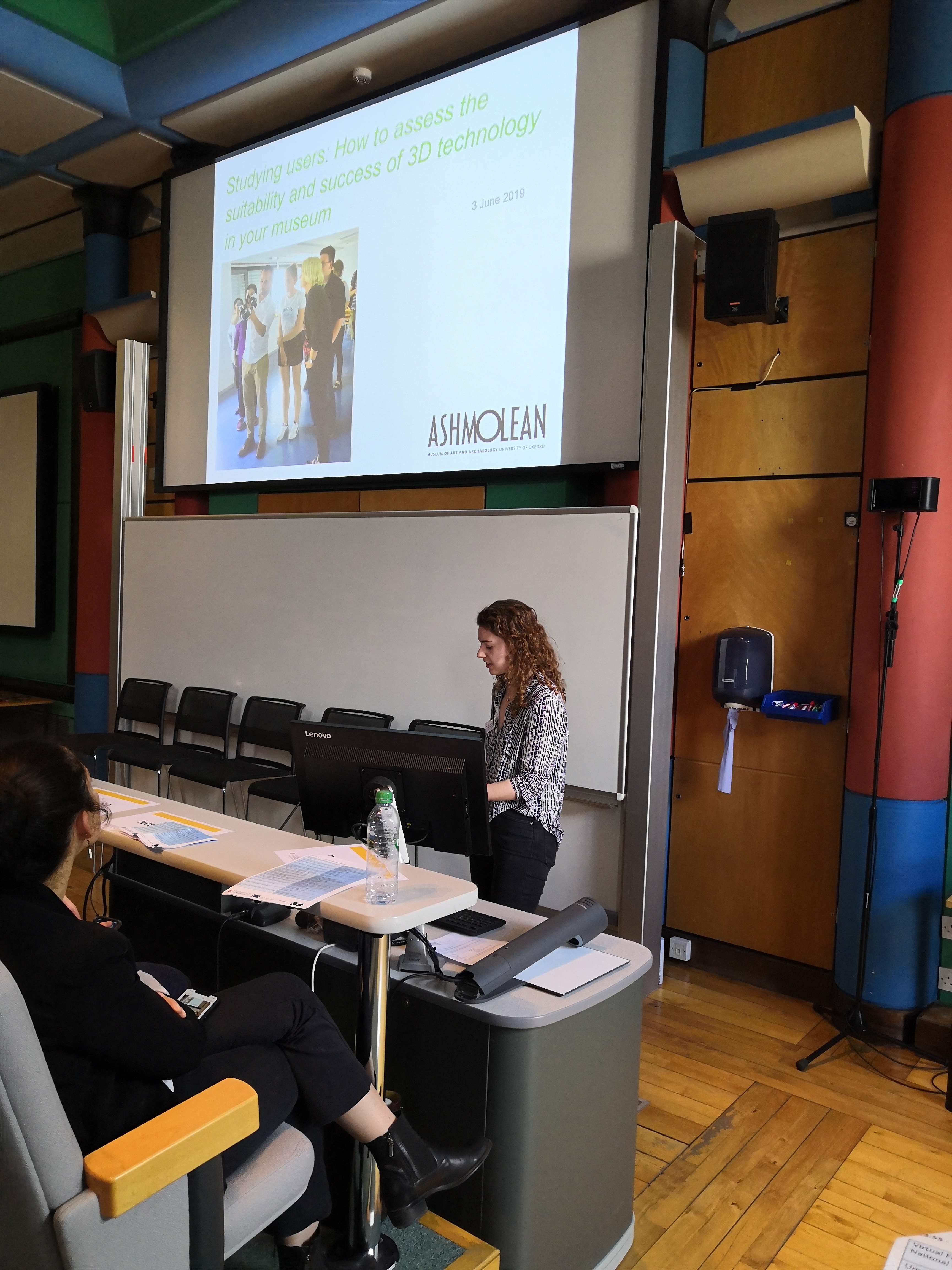
After a speedy lunch we were back to an intense afternoon session of quick fire talks. 19 talks, 5 minutes a talk: it was a challenge!
Susanne Turner of the Museum of Classical Archaeology in Cambridge kicked us off with a live skype tour of the Cast Gallery literally and figuratively walking us through the issues they encounter at the museum with people touching, and breaking, objects and adding graffiti to others. She felt their issues were particular poignant in their collection as it is made up of casts made during the 19th century. Visitors feel they have more of a “Right” to touch as the objects aren’t “originals”. She is worried about introducing any tactile installations in the gallery as she worries it might further confuse visitors as to whether they are allowed to touch or not. It was an excellent paper that ended with the final question of “Do you want to see the foreskin?”
The next two talks were prerecorded presentations from Madeline Robison and Alix Thoeming of University of Sydney. Madeline’s paper considered the 3d imaging and preservation of the mummy of the boy Horus. Her paper was fascinating but did spark some ethical discussion on twitter regarding the imaging of human remains.
Interesting talk from Madeline Robinson about the scanning and analysis of a mummy. I have some conflicting feelings about photographs and modelling of human remains, however old. 'Horus will be preserved in this digital realm where he can be studied forever.' #ceef3D
— George (@georgeopteryx) June 3, 2019
Alix turned to a different use of photogrammetry: as a tool for supporting student assessment.
The ReACH Reproduction of Art and Cultural Heritage project was next up. Anais Aguerre gave us an overview of the global initiative that explores how to re-think our approach to reproducing, storing and sharing works of art and cultural heritage. I was particularly impressed by the gender balance of the team behind the project.
Great to hear @AnaisAguerre speak about the importance of a collaborative roadmap for digital outputs in the new landscape for museums based on the #Reachproject at the @V_and_A #CEEF3D pic.twitter.com/p8UjliQwzY
— Elizabeth Galvin (@LisaGalvin_) June 3, 2019
Turning to Art History, Donal Cooper gave the next presentation; an overview of a new project that is about to launch exploring Renaissance Florence. The project brings together GIS, geo-located mobile mapping and 3D visualization and is a collaboration between Univesity of Cambridge, University of Exeter and University of Toronto. There is a lot of potential here to go multisensory and consider a broader definition of experience than vision alone.
The session also featured two presentations from the “Unveiling the invisible: a mathematical touch to challenges in Cultural Heritage” project. Both Kasia Targonska-Hadzibabic and Simone Parisotto discussed how the project will use image analysis techniques to process digital collections, specifically working with the manuscripts department.
Amy Scott-Murray discussed the fabulous work the Natural History Museum are doing negotiating recording collections and information across at a huge range of different scales, considering items from the museum collections up to recording in situ remains. Lee Robert McStein followed on nicely by presenting on his work scanning animal mummies and talked about the range of digital recording techniques deployed (for both surface recording and internal scanning) and some of the low-cost solutions he’s been developing, we all loved the integration of an Ikea lazy Susan.
As a photogrammetry newby @Monument_Men low-fi hacks are very useful and helpful #ceef3d
— Sophie Crump (@S_Crumpie) June 3, 2019
Rafie Cecilia’s presentation was one of the highlights of the day for me. Her work explored the use of 3D prints with visually impaired audiences. Personally I feel this is where we have seen the most affective uses of 3D printing in the museum sector to date. Her paper nicely paired with Elizabeth Galvin who considered the requirements of SEN users to access museum collections and championed the use of 3D prints for helping to understand object use.
There was a discussion from George Cooper concerning the potential for creating publications which integrate 3D through a partnership between Routledge and Sketchfab. This would be really useful to see more and as the wonderful Internet Archaeology has always said online publications have the potential to be “more than just an pdf”.

Another highlight of the afternoon was Ian Dawson’s presentation on Messy Assemblages, his work using 3D printing to negotiate the physical and digital divide and further as a means to negotiate colonial collections was timely.
There were two papers exploring digital applications to Egyptian archaeology in the afternoon from Nicky van de Beek and Amanda Ford Spora who considered 3D applications as outreach tools.
Both Ronald Haynes and Dave Fletcher presented fairly tech-heavy presentations firstly on using technology to disrupt how we view things then as part of an exercise guerrilla scanning at the British Museum.
Fiona McKendrick brought us all back to the issue that while doing all this cool stuff is ace we also need to ensure we are evaluating the success of our endeavors. I would have been interested to see a discussion with Rafie develop over the nature of this evaluation as I think that looking at both quantitative and qualitative data is important.

Finally Maciej Pawlikowski did a fantastic job of rounding off the session by opening with some humour and continuing with an excellent presentation concerning a small Sumerian tablet in the Cambridge Digital Library.
@mmpawlikowski deserves a giant G&T (in Glen Measurements™️) for that joke (and also for going last of all our speakers!) 💪 #ceef3d
— Abi L. Glen (@abilglen) June 3, 2019